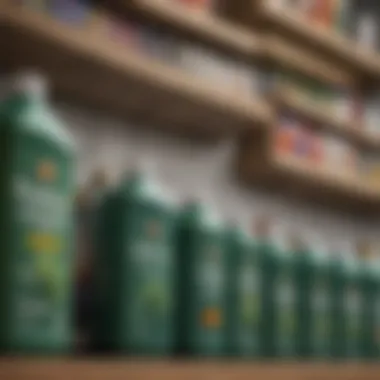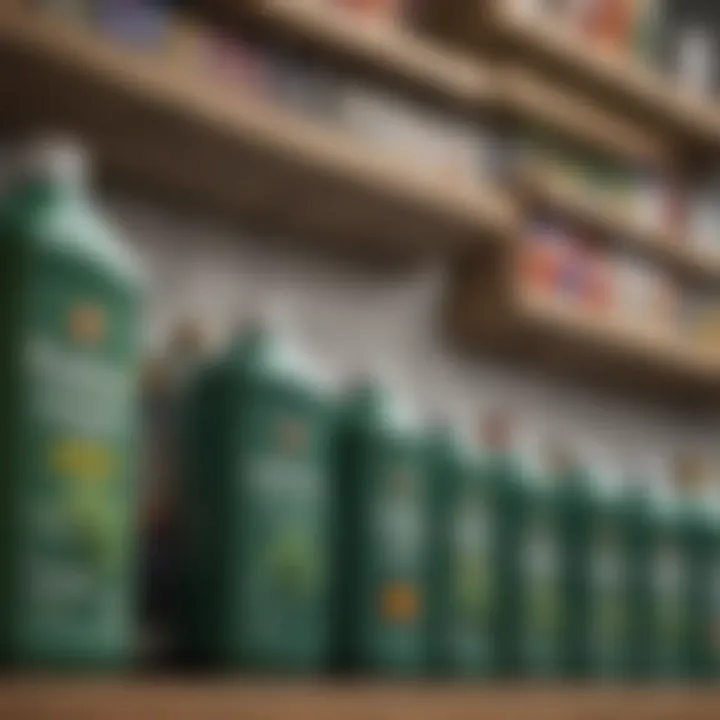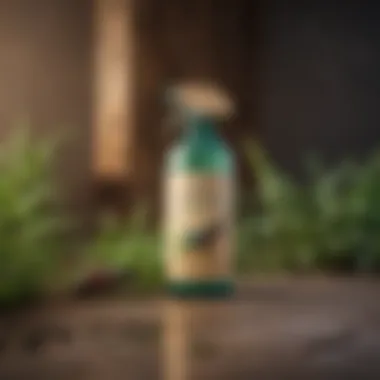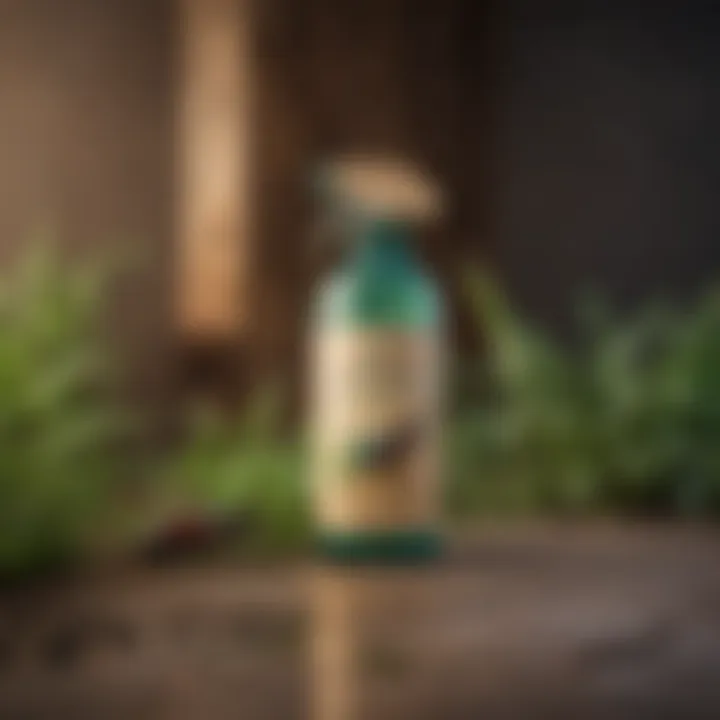The Best Insecticide: Effective Solutions for Home & Garden


Intro
Choosing the proper insecticide can feel overwhelming. With countless products available on the market, knowing what is effective for your home and garden is crucial. Insecticides serve to protect plants and living spaces from harmful pests. However, evaluating the differences between chemical and natural options is necessary. This article sheds light on these distinctions, offering insights into active ingredients, application methods, and safety considerations. Making informed choices promotes not just the wellbeing of your plants but also the health of your environment.
Design Inspiration
Understanding how design plays a role in gardening can guide your choice of insecticide. Aesthetic considerations and practicality often interplay, especially when designing a garden. The goal is to create a balanced environment where plants thrive without the interference of pests.
Trending Styles
Several trends emerge in garden design and pest management. Organic gardening is gaining momentum, which favors using natural insecticides over synthetic ones. This push for sustainable practices has led many to explore options like neem oil and insecticidal soap. These solutions not only repel insects but also maintain a visually pleasing landscape.
Color Palettes
When selecting plants for your garden, colors can also impact insect activity. Brightly colored flowers may attract beneficial insects while deterring harmful ones. Incorporating a diverse color palette encourages natural pest control by attracting pollinators and other beneficial species, potentially reducing the need for insecticides altogether.
Practical Tips
To ensure your gardening endeavors succeed, a strategy for pest management is essential. Knowing when and how to apply insecticides can significantly affect their effectiveness.
Maintenance & Care
Regular maintenance is the backbone of a thriving garden. Inspect plants frequently for signs of pest infestations. Early detection mitigates the need for more potent insecticides. Use organic options first, as they are less likely to harm beneficial insects. If necessary, a targeted approach to synthetic options can be applied with caution. Always follow label directions for proper application.
Budgeting & Planning
Effective pest control doesn't have to be costly. Researching and comparing products may help you understand which are most effective for your specific needs. Consider creating a budget that allocates a portion of funds toward preventative measures. This might include companion planting, which involves growing plants together that repel pests naturally.
"Understanding the balance between pest control and maintaining ecological health is fundamental in gardening."
By systematically exploring options and being informed, homeowners and gardening enthusiasts can make choices that benefit both their spaces and the surrounding environment.
Prelude to Insecticides
Insecticides play a crucial role in pest management, particularly in home and garden settings. Their primary function is to target and eliminate various pests that can pose threats to plants, animals, and even human health. Understanding the landscape of insecticides is essential for homeowners and gardening enthusiasts alike. Knowledge about these solutions not only empowers individuals to protect their spaces but also to make informed decisions regarding their use.
The significance of insecticides extends beyond merely controlling pests. These products can significantly influence the overall health of gardens and indoor plants, encouraging growth and preventing crop damage. With the rise of organic gardening and increased awareness of environmental impacts, the selection of appropriate insecticides has become a pivotal consideration. Homeowners should evaluate their specific needs against the backdrop of safety, efficacy, and environmental responsibility.
Definition and Purpose
Insecticides are substances designed to kill or manage insect populations. They come in various formulations and types, each targeting distinct pests or pest categories. The fundamental purpose of these chemicals is to mitigate the effects of harmful insects while allowing beneficial species to thrive. Effective management helps maintain the ecological balance in gardens and homes. Different applications can benefit specific environments, making it essential to comprehend the nuances of insecticides when trying to choose the right one.
Historical Context
The use of insecticides has a long history that can be traced back to ancient civilizations. From burning sulfur to deter pests in ancient Egypt to the introduction of synthetic chemicals in the 20th century, human efforts to control insect populations have evolved substantially. Early methods emphasized natural substances, but this evolved into the development of synthetic compounds designed for greater efficacy.
However, the reliance on chemicals has raised alarm regarding the environmental consequences. Issues around toxicity, resistance development in insect populations, and adverse effects on non-target species have surfaced. Consequently, modern practices tend to integrate historical approaches with new insights concerning environmental stewardship and sustainable practices. In sum, exploring insecticides means looking at both their immediate benefits and long-term consequences.
Types of Insecticides
Understanding the various types of insecticides is crucial for effectively managing pest issues in home and garden settings. This section elucidates the classifications of insecticides, exploring their unique features, benefits, and practical considerations. By delving into chemical, natural, and biological insecticides, readers will gain a holistic perspective that aids in making informed choices tailored to their specific needs and environmental contexts.
Chemical Insecticides
Chemical insecticides are synthetic substances designed to kill or repel pests. They are often favored for their immediate effectiveness and broad-spectrum action against a wide variety of insects. Common active ingredients include pyrethroids, neonicotinoids, and organophosphates. These compounds work by disrupting essential biological functions of targeted pests, leading to their rapid demise.
While chemical insecticides can be highly effective, they also come with certain risks. Over-reliance on these products can lead to pesticide resistance, where pests develop an immunity to specific chemicals, making them harder to control over time. Additionally, there are concerns about potential effects on non-target organisms, including beneficial insects, pets, and even humans. Homeowners must consider these factors seriously when deciding on their usage.
Natural Insecticides
Natural insecticides derive from plant or mineral sources and often offer a less toxic alternative to synthetic chemicals. Popular options include neem oil, Diatomaceous earth, and pyrethrum, which is extracted from chrysanthemum flowers. These substances can disrupt insect life cycles by deterring feeding, disrupting reproduction, or causing physical harm.
One of the main benefits of natural insecticides is their reduced impact on the environment. Unlike their chemical counterparts, they are often biodegradable and generally pose less risk to beneficial insects and the surrounding ecosystem. However, effectiveness may vary and usually takes longer to notice compared to chemical variants. Homeowners interested in sustainable gardening practices may find natural insecticides an appealing option.
Biological Insecticides
Biological insecticides consist of living organisms or natural products derived from them, aimed specifically at targeting pest populations. Examples include Bacillus thuringiensis (Bt), a bacterium that produces toxins harmful to certain insects, and entomopathogenic nematodes, which are microscopic worms that can infect and kill pests.
The advantage of using biological insecticides lies in their specificity. For instance, Bt is effective primarily against caterpillars, minimizing harm to other insects. This makes them suitable for integrated pest management (IPM) practices that focus on ecological balance. Furthermore, biological options tend to encourage the health of beneficial species, promoting a more robust garden ecosystem.
Understanding Active Ingredients
Understanding the active ingredients in insecticides is crucial for making informed choices. These ingredients are the chemical or natural agents responsible for the insecticidal effect. The effectiveness, safety, and environmental impact of the product can greatly depend on these components. Knowing the properties and potential effects of active ingredients helps homeowners select the right solution for their specific pest control needs.
Common Chemical Compounds
Chemical insecticides often rely on a range of synthetic compounds. Among the most common are pyrethroids, organophosphates, and neonicotinoids.


- Pyrethroids: These mimic the natural insecticides found in chrysanthemum flowers. They target the nervous system of insects and are effective against a wide range of pests.
- Organophosphates: These compounds affect the enzyme systems within pests, disrupting normal functions. While effective, they also require careful handling due to potential toxicity to humans and pets.
- Neonicotinoids: These disrupt the transmission of impulses in the nervous system of insects, leading to paralysis and death. However, their use has raised environmental concerns, especially regarding their effect on pollinators like bees.
It's necessary to consider not just effectiveness but also the specific ingredients listed on product labels when selecting a chemical insecticide.
Essential Oils and Natural Extracts
Natural insecticides often utilize essential oils and plant extracts as active ingredients. Many of these substances have insect-repelling properties without the harsh effects of chemicals.
- Neem Oil: Extracted from the seeds of the neem tree, this oil is effective against a range of soft-bodied insects. It disrupts their life cycle and can also act as a repellent.
- Peppermint Oil: Known for its refreshing scent, peppermint oil can repel ants, spiders, and certain flying insects. It's safe for indoor use and non-toxic.
- Lavender Oil: Besides its pleasant aroma, lavender oil is an effective repellent against moths, fleas, and other pests.
Using essential oils can be an eco-friendly approach, but it is important to note that they may need to be reapplied more frequently than chemical alternatives due to quicker degradation.
Microbial Agents
Microbial insecticides are another category that uses naturally occurring pathogens to control pests. These agents are often derived from bacteria, fungi, or viruses.
- Bacillus thuringiensis (Bt): A common bacterium used in gardens, it produces toxins that are harmful to specific insect larvae without affecting humans or non-target species.
- Beauveria bassiana: This fungus can infect and kill various insects, such as aphids and whiteflies, by infiltrating through their exoskeletons.
- Nematodes: These microscopic worms target insects in the soil. They enter their hosts and release bacteria that kill the pests internally.
Microbial agents are relatively safe for humans and pets, making them appealing choices for organic gardening.
Understanding what is in the insecticides you use is essential. It helps minimize risks to health and the environment while effectively tackling pest issues.
Selection of Insecticide
Selecting the right insecticide is a crucial step in effectively managing pest problems in your home and garden. This section emphasizes the importance of understanding your specific needs and the factors contributing to successful pest control. Homeowners should recognize that not all insecticides are created equal. Depending on the targeted pest, the environment, and safety considerations, the right choice can significantly influence the outcome of your pest management strategy.
Identifying the Target Pest
The first crucial step when selecting an insecticide is identifying the target pest. Knowing what type of insect you are dealing with helps narrow down the most effective options. Different insects respond to various active ingredients. For instance, a pesticide effective against aphids might not have the same effect on spiders.
To successfully identify the pest, homeowners can observe their physical characteristics such as size, color, and other identifying features. Consulting local garden centers or online resources can also prove beneficial. Accurate identification not only informs your insecticide choice but also allows for more targeted application, minimizing unnecessary chemical exposure to beneficial insects or the environment.
Evaluating Your Environment
After identifying the target pest, the next step is evaluating your environment. Considerations such as the type of plants present, the layout of your garden or yard, and potential re-entry areas into your home are essential. Some insecticides may be more suitable for vegetable gardens, while others are designed for ornamental plants.
Homeowners should also account for their living situation. If you have children or pets, specific insecticides may pose safety risks. Moreover, certain environments like greenhouses or covered patios may allow for the use of more potent chemicals, as they limit exposure to other fauna. Being informed about your surroundings ensures that you select an insecticide that effectively addresses your pest problem while safeguarding your home and garden.
Assessing Safety and Efficacy
Finally, assessing safety and efficacy is vital in the selection process. Homeowners must consider both the immediate and long-term impacts of the pesticide they choose. An insecticide might be effective at eliminating pests but could also pose health risks if not used correctly.
Individuals should review labels and safety data sheets, paying close attention to information regarding toxicity levels and environmental effects. It is also beneficial to consult resources like the Environmental Protection Agency or gardening forums for insights on safer alternatives.
Safety should not be overlooked. Using personal protective equipment (PPE) during application is paramount. Additionally, knowing the proper application techniques can enhance both the efficacy and safety of the selected insecticide.
"The selection of an insecticide is as much about safety and responsibility as it is about effectiveness."
In summary, understanding the specific pest, evaluating your environment, and considering safety and efficacy in your selection process can lead to more informed decisions. This ultimately results in a more effective pest management strategy that aligns with your needs and values.
Application Methods
Insecticides vary not only in their formulation but also in how they can be applied. Understanding the application methods is crucial for maximizing effectiveness while minimizing risks. The choice of application greatly influences the pest control outcomes in both home and garden settings. Three primary methods include sprays and aerosols, granular and powders, and drenches and baits. Each method has distinct advantages and considerations that homeowners should take into account for optimal results.
Sprays and Aerosols
Sprays and aerosols are among the most common ways to apply insecticides. Their ease of use makes them a preferred choice for many homeowners. These products can quickly cover large areas, making them ideal for treating widespread infestations. Additionally, they allow for direct targeting of pests, ensuring that the active ingredients reach the intended organisms effectively.
When using sprays, it is important to consider the wind direction and weather conditions. Wind can carry the spray away from the intended area, reducing effectiveness and posing risks to non-target plants or beneficial insects. Using a fine mist can help mitigate drift. Moreover, applying in the early morning or late evening can reduce evaporation, enhancing absorption on plant surfaces.
Remember: Always read the label instructions carefully to apply at the recommended dosage and frequency for safety and efficiency.
Granular and Powders
Granular insecticides and powders serve a different purpose than liquid formulations. They are particularly effective for soil application and tackling pests residing in the ground. Granules are often scattered on the soil surface or incorporated into the soil, where they dissolve and release active ingredients over time. This method is effective against pests like grubs or ants that may inhabit the soil.
Using powders, on the other hand, allows for targeted application directly onto plants or areas where insects are seen. This method is especially useful for controlling crawling pests like beetles and ants. However, care must be taken not to over-apply, as granules and powders can linger in the environment and potentially harm beneficial organisms.
Drenches and Baits
Drenches and baits provide effective solutions for controlling pests that are harder to reach with sprays. Drenching involves applying a liquid insecticide directly to the soil or plant base, where it is absorbed by the roots. This method is particularly useful for fighting soil-borne pests, offering long-lasting protection as the plant takes up the chemicals.
Baits, conversely, are designed to attract pests, which then consume the insecticide mixed within. This method works well for certain insects like cockroaches and termites. It enables a more targeted approach, minimizing the impact on non-target species. However, the effectiveness of baits relies on the pest's attraction to the bait, making it crucial to choose the right formulation.
Safety Considerations
Safety considerations are a vital aspect of using insecticides effectively and responsibly. Homeowners and gardening enthusiasts often overlook safety in the quest for pest control, but proper awareness and action can make a significant difference. The use of insecticides should not come at the cost of personal or environmental well-being. In this context, understanding safety measures involves recognizing potential hazards, utilizing protective equipment, and being mindful of how chemicals affect the surroundings and human health.


Personal Protective Equipment
Employing personal protective equipment is essential when handling insecticides. This equipment serves to minimize risk and safeguard against harmful exposure. Common items include gloves, masks, and goggles, which act as barriers between the chemicals and the body. Gloves prevent skin contact, while masks help avoid inhaling toxic particles. Goggles protect the eyes from splashes or residue.
It is crucial to choose the right type of protective gear, ensuring it is suitable for the specific insecticide being used. Always check the manufacturer’s label for recommendations regarding protective equipment. Furthermore, proper fit and maintenance of these items can enhance their effectiveness.
Environmental Impact
The environmental impact of using insecticides cannot be understated. Certain chemicals can leak into the soil and waterways, disrupting local ecosystems. The consequences can range from harming beneficial insects, such as pollinators, to contaminating drinking water sources.
To address this issue, users should consider the types of insecticides being applied. Natural and less toxic options may pose fewer risks to the environment. Moreover, being mindful of application methods can mitigate adverse effects. For example, avoiding application near water bodies or during heavy rain can prevent runoff.
Preventing Chemical Exposure
Preventing chemical exposure is critical for protecting both human health and the environment. To minimize risks, users should follow all label instructions meticulously. This includes not only dosage but also application timing and storage conditions. Proper storage in a secure location can deter accidental exposure, especially for homes with children or pets.
Educating oneself about safe practices also plays an important role. Using insecticides responsibly means understanding when to apply them and recognizing situations that may require less chemical intervention, such as fostering healthier plants or integrating pest management strategies.
"Knowledge is power, especially when it comes to ensuring safe and effective use of insecticides."
Regulations and Standards
Understanding regulations and standards governing insecticides is crucial for anyone involved in home and garden applications. These regulations ensure that products are safe and effective for both users and the environment. Compliance with these standards can help in making informed choices when selecting insecticides. They guide manufacturers in developing products that minimize risks while maximizing efficacy.
One key element of these regulations is to oversee the ingredients used in insecticide formulations. This prevents the use of harmful substances that can pose health risks to humans, pets, and beneficial insects. By ensuring compliance, regulatory bodies promote safer insecticide options available to consumers. Furthermore, these standards also foster public trust in pest control solutions, reaffirming that chosen products align with health and environmental safety.
In terms of benefits, understanding these regulations allows homeowners to make educated decisions regarding pest management. By selecting insecticides that adhere to regulatory standards, users can effectively manage pest problems without compromising their values or risking safety. These regulations also encourage research and development in the field of pest management, driving innovation toward safer methods to control pests.
In summary, regulations and standards serve as the foundation for safe usage of insecticides in homes and gardens. Consumers benefit not only from greater safety but also from the assurance that recommended products have met stringent criteria for effectiveness and environmental stewardship.
EPA Guidelines
The Environmental Protection Agency (EPA) plays a crucial role in overseeing the safety and efficacy of insecticides sold in the United States. The EPA establishes guidelines that manufacturers must follow to ensure their products are suitable for public use. This includes rigorous testing and evaluation processes before any insecticide can be approved for market.
When a new insecticide is submitted for review, it undergoes various procedures, including:
- Assessment of health risks to humans and pets
- Evaluation of environmental impacts
- Long-term studies to observe any adverse effects
The significance of EPA guidelines extends beyond health risks. These guidelines also help ensure that insecticides do not disrupt ecosystems, which can lead to unintended consequences, such as the decline of beneficial insect populations. Knowing that products meet EPA standards gives both homeowners and gardeners peace of mind when dealing with pest issues.
Organic Certification
Organic certification is an essential aspect for those looking for natural alternatives to chemical insecticides. This certification indicates that a product meets specific standards set forth by the USDA for organic farming and gardening practices. For insecticides, organic certification ensures that they are derived from natural sources without synthetic chemicals in their formulation.
Some key components of organic certification for insecticides include:
- Use of naturally occurring ingredients, such as oils or plant extracts
- Prohibition of synthetic pesticides or herbicides
- Compliance with sustainable practices, promoting ecological balance
Homeowners seeking organic options benefit by having access to safer pest control methods that are less likely to harm beneficial insects. Organic certification also supports sustainable agriculture, encouraging practices that protect the environment and preserve soil health.
Product Reviews
Product reviews hold significant value in the context of insecticides for several reasons. First, they provide users with real-world insights into the effectiveness of various products. Homeowners, gardeners, and DIY enthusiasts often rely on these insights before making purchasing decisions.
Furthermore, reviews serve as a critical tool for consumers to understand not just the successes of a product but also its limitations. The importance of this transparency cannot be overstated. It encourages informed decision-making, essential for achieving the desired outcomes in pest management.
When considering product reviews for insecticides, it is vital to look for specific elements. These include:
- Efficacy: How well does the insecticide perform against specific pests?
- Application ease: Is the product user-friendly?
- Safety: What precautions do users recommend regarding personal and environmental safety?
- Value for money: Does the cost align with its effectiveness?
In essence, the reviews create a more holistic view of each option. This approach helps ensure that consumers can align their choices with their specific needs and environmental considerations.
"Understanding both strengths and weaknesses of insecticides through reviews can lead to more sustainable pest management practices."
Next, let's turn our attention to the top chemical insecticides available, exploring which products are leading the market currently.
Best Practices for Use
Understanding the best practices for using insecticides is crucial for achieving optimal results while minimizing potential risks. Insecticides are powerful tools, and using them responsibly ensures both effective pest control and safeguarding the environment. This section will focus on the importance of timing the application and employing methods of prevention to enhance effectiveness.
Timing of Application
Timing plays a vital role in the effectiveness of insecticides. The right timing can significantly increase the chances of successful pest eradication. Different pests have specific life cycles, and understanding these cycles is essential for effective management. For instance, targeting pests during their active phases, such as when they are feeding or mating, optimizes the possibility of the insecticide making contact.
Moreover, weather conditions can also influence application timing. Wind, rain, and temperature all impact how insecticides behave once applied. Ideally, applications should be made on calm days, avoiding windy conditions that could cause drift. Similarly, applying insecticides before rain can wash away treatments, reducing efficacy. Keeping an eye on local weather forecasts can prevent potential setbacks and maximize product performance.
Methods of Prevention


Prevention is always better than a cure. By implementing preventive measures, homeowners can significantly reduce the likelihood of infestations in the first place. Here are essential considerations for pest prevention:
- Regular Maintenance: Keeping gardens and home interiors well-maintained discourages pest attraction. Regularly trimming shrubs, removing debris, and managing waste are key tasks.
- Sanitation Practices: Keeping spaces clean and food sealed limits food sources for pests like ants or cockroaches. Proper sanitation can prevent pests from becoming a nuisance.
- Properly Sealing Entrances: Inspect and seal gaps around doors, windows, and foundations. This simple action prevents pests from entering homes.
- Natural Barriers: Using plants that repel specific pests can be an effective method of natural pest control. For example, marigolds can deter nematodes, making them a good addition to gardens.
Using a combination of preventive measures can significantly mitigate the need for further insecticide use.
Common Misconceptions
Common misconceptions about insecticides can lead to improper use and misunderstanding of their role in both home and garden settings. These inaccuracies may affect how homeowners approach pest management strategies. It is important to clarify these issues to inform effective decisions and promote safety in application practices.
Insecticides vs. Pesticides
A common misconception is that insecticides and pesticides are interchangeable terms. However, they serve different purposes. Pesticides encompass a wider category of chemicals used to kill pests, which can include insects, weeds, fungi, and rodents. Within this category, insecticides specifically target insect populations. Understanding this distinction is vital for effective pest control. Misusing an insecticide when a herbicide is required, for example, can result in inadequate treatment and prolonged pest problems.
It's essential to assess the specific pest problem before selecting a product.
- Targeted Solutions: Use insecticides for insect-related issues, while herbicides address plant problems.
- Safety Standards: Different regulations may apply to insecticides and other types of pesticides, which affect safety measures and application guidelines.
Safety Myths
Another area of misconception concerns the safety of insecticides. Many people believe that all insecticides pose significant health risks. While it is true that improper use can lead to dangers, many modern formulations are designed with safety in mind. For instance, natural insecticides often have lower toxicity levels than their chemical counterparts.
It is crucial to consider the following when thinking about safety:
- Read Labels: Always refer to the label for safe usage, including recommended protective gear.
- Proper Application: Following guidelines helps reduce risks to health and the environment.
- Misguided Perception: Some view organic or natural products as risk-free, but these can also cause harm if not applied correctly.
"Many believe that because a product is labeled as organic, it is inherently safe—a notion that might lead to negligence in safe handling."
Understanding the nuances of safety related to insecticides and pesticides can allow homeowners to make informed decisions that balance efficacy and safety good.
In summary, clarifying these misconceptions empowers individuals to approach pest management with more knowledge. This ensures the effective use of products, achieving desired results without compromising safety.
Future of Insecticides
The landscape of insecticide use is evolving. As awareness around environmental issues rises, the demand for more effective and sustainable solutions is becoming paramount. Farmers, gardeners, and homeowners must pay attention to the changing trends in pest control. This section explores emerging technologies and sustainable practices that shape the future of insecticides, pointing to an industry that is adapting to meet new challenges while keeping safety in focus.
Emerging Technologies
Innovation in insecticide technology plays a significant role in future pest management. Many studies are underway looking into genetic engineering and biopesticides. These methods offer solutions that minimize chemical exposure and potential health risks.
Several new technologies include:
- Nanotechnology: This is the manipulation of matter at the atomic level. Nanoparticles can deliver insecticides more effectively, increasing the efficacy while potentially reducing the required quantities.
- Smart Traps: These devices can detect and monitor pest populations. They provide real-time data, allowing for targeted treatments, reducing the reliance on broad-spectrum insecticides.
- Gene Editing: Techniques like CRISPR allow for modification of pest resistance or enhancement of natural predator species. This can lead to reduced pest populations over time without the use of traditional chemicals.
Emerging technologies not only improve efficacy but also address consumer concerns on environmental impact. Greater efficiency also translates to less product usage, which is both cost-effective and eco-friendly.
Sustainable Practices
Sustainable practices are progressively influencing how insecticides are developed, marketed, and used. This paradigm shift encompasses a variety of strategies, focused on long-term ecological health rather than short-term results.
Key sustainable practices include:
- Integrated Pest Management (IPM): This approach emphasizes understanding the lifecycle of pests and utilizing a combination of biological, cultural, and chemical control methods. By implementing IPM, reliance on synthetic insecticides decreases, minimizing environmental risks.
- Organic Certifications: Many consumers now prefer organic solutions for pest control. Organic insecticides often impose less harm on the ecosystem. When used properly, these products can manage pests effectively without the side effects that synthetic options may carry.
- Biodiversity Conservation: Encouraging natural predators can mitigate pest issues. Providing habitats for beneficial insects helps maintain ecological balance, reducing the need for insecticides altogether.
"The shift towards sustainable insecticide use reflects broader ecological awareness and a commitment to health—both for people and the planet."
In the end, the future of insecticides appears to be not just about managing pests but also about nurturing the environment. Homeowners and gardeners ought to embrace these advancements, making informed choices that reflect a commitment to sustainability.
Epilogue
The conclusion serves as a crucial wrap-up of the insights and information discussed regarding insecticides. This final section not only reinforces the key messages but also emphasizes the significance of using the right solutions for pest control in home and garden settings. As pests can lead to significant damage to crops and structures, understanding the available options is essential for homeowners and gardening enthusiasts alike.
One of the primary benefits of comprehending the various insecticides available is the ability to make informed decisions. Readers can evaluate their specific situations, whether dealing with a small home garden or larger agricultural areas. The knowledge gained throughout the article allows individuals to choose products that align with their values, whether they prefer natural methods or traditional chemical applications.
Moreover, considering the environmental impact of insecticides is becoming increasingly important in our consumption choices. The balance between efficacy and safety must be weighed carefully. Buyers should reflect on both immediate results and long-term effects on the surrounding ecosystem. By understanding these factors, one can contribute to more sustainable practices in pest management.
The act of making an informed choice hinges on assessing both the benefits and potential risks. This awareness can lead to more ethical use of products that avoid unnecessary harm to beneficial insects and the environment.
"Education is the foundation for making better decisions in pest management practices."
In summary, the conclusion synthesizes the importance of the topic, urging readers to reflect on the implications of their choices in selecting insecticides. It highlights how informed decisions can enhance not only personal satisfaction but also environmental wellness.
Key Takeaways
- Different types of insecticides include chemical, natural, and biological varieties, each with distinct uses and impacts.
- Understanding active ingredients is key for effective pest management, allowing for targeted applications against specific pests.
- Environmental considerations should guide the selection process of insecticides to promote sustainability.
- Safety measures and regulations help in minimizing potential health risks for users and local ecosystems.
Making an Informed Choice
To make an informed choice when selecting insecticides, consider the following factors:
- Target Pest: Identify the pests you are dealing with. Knowing this helps in choosing the most effective solution.
- Environment: Assess your living and gardening conditions. Some products may be more suited for indoor use while others may be for outdoor environments.
- Active Ingredients: Research and understand the active ingredients in insecticides. This knowledge can alert you to possible side effects or environmental impacts.
- Efficacy: Look for product reviews and recommendations to determine the effectiveness of various insecticides in real-world scenarios.
- Safety Measures: Always review safety instructions and consider protective equipment when applying any pest control products.
By attentively navigating these considerations, individuals can ensure their pesticide choices align with their needs, values, and safety requirements.















